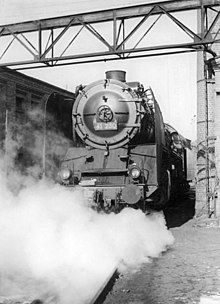Lokomotivbau Karl Marx Babelsberg
| VEB Lokomotivbau Karl Marx Babelsberg (LKM) | |
|---|---|
| legal form | publicly-owned business |
| founding | 1948 |
| resolution | 1992 |
| Seat | Potsdam - Babelsberg , German Democratic Republic |
| Branch | Locomotive manufacturer |

The VEB Lokomotivbau Karl Marx Babelsberg ( LKM ) was a manufacturer of locomotives in Potsdam - Babelsberg ( DDR ). The formerly publicly owned company was closed in 1992.
history

The LKM emerged from the Babelsberg plant of the Maschinenbau und Bahnbedarf Aktiengesellschaft , previously Orenstein & Koppel . After the Second World War, vehicle repairs were initially resumed in 1946. On April 30, 1947, the first post-war locomotive was delivered, the prototype for the SŽD series ГР . The locomotives were delivered to the Soviet Union as reparations .
On March 18, 1948, it was incorporated into VVB LOWA as Lokomotivbau Karl Marx Babelsberg , or LKM for short. The plant was a producer of the new locomotives of the series 25.0-1 , 23.10 , 50.40 , 65.10 , 83.10 , 99.23-24 , LKM type 225 HP narrow gauge (99.33) and 99.77-79 . With the delivery of the machine 50 4088 on December 28, 1960, the steam locomotive construction for the standard gauge in Germany ended.
The GDR's first diesel locomotive type program started in 1950 with types N1 to N7, of which narrow-gauge variants with the suffix s (for example Ns1) were offered. The variants N5 to N7 were not built, prototypes of the N5 and N7 existed, but they were not ready for series production until later .

In 1958 the second diesel locomotive type program was started. The locomotives were now given designations from V 10 to V 240 based on the performance values and the axle formula. The V 10 B had 100 hp and two axles, the V 180 BB 1800 hp and four axles in two bogies.
The production of steam locomotives was ended in 1960, but in 1969, due to the energy crisis, the construction of fireless C- type steam storage locomotives began.
As early as 1964, part of the diesel locomotive production was transferred to the Lokomotivbau Elektrotechnische Werke "Hans Beimler" Hennigsdorf . The construction of large diesel locomotives was ended in 1970 because, according to new COMECON resolutions, the Soviet Union and Romania were responsible for this power class. The last locomotive was delivered in 1976.
The company concentrated on other production focuses, so from January 16, 1969 the company traded as VEB Klimatechnik Karl Marx Babelsberg . In 1974 production changed again, from April 1, 1974 the company called itself VEB Maschinenbau Karl Marx Babelsberg and was part of the TAKRAF combine . He manufactured the 125 car slewing crane , which was followed by the ADK 70 , ADK 80 and ADK 100 truck cranes based on series trucks .
With the cessation of locomotive construction in 1976, the company left the GDR rail vehicle construction combine . In 1984 he was integrated into the IFA Combine Commercial Vehicles Ludwigsfelde .
In 1990 the mechanical engineering company Karl Marx Babelsberg was converted into a GmbH by the Treuhandanstalt and then liquidated by 1992, although there were serious development offers. Today there is an industrial park on the site.
literature
- Udo Kandler: Lokomotivbau "Karl Marx", the locomotive forge of the GDR in Babelsberg . EK-Verlag GmbH, Freiburg 2018, ISBN 978-3-8446-6224-5 .
Web links
Individual evidence
- ↑ a b Klara van Eyll , Beate Brüninghaus, Sibylle Grube-Bannasch (eds.): German economic archives. Evidence of historical sources in companies, chambers and associations of the Federal Republic of Germany. Volume 1. Edited by Renate Schwärzel. 3rd, completely revised edition. Steiner, Stuttgart 1994, ISBN 3-515-06211-4 .
- ↑ Sold for stupid . In: Der Spiegel . No. 14 , 1992, pp. 145-147 ( online ).
Coordinates: 52 ° 22 ′ 48 ″ N , 13 ° 6 ′ 58 ″ E
